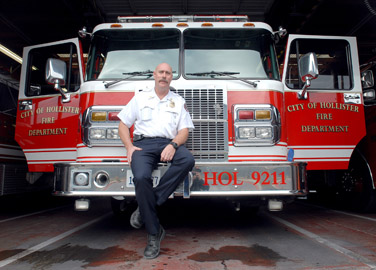
Interim fire chief Cheshire takes over top post
Hollister native Fred Cheshire recognizes the challenges before
him as chief of the city’s fire department. From funding to
staffing to handling a record number of calls, the 19-year veteran
said he looks forward to leading the two-station department into
the future.
Cheshire, who has spent his entire firefighting career in
Hollister, has seen the community grow from a place where a day
with four or five calls was considered busy to today, when he
says
”
we don’t even talk about being busy until we’re over 10 calls in
a day.
”
Interim fire chief Cheshire takes over top post
Hollister native Fred Cheshire recognizes the challenges before him as chief of the city’s fire department. From funding to staffing to handling a record number of calls, the 19-year veteran said he looks forward to leading the two-station department into the future.
Cheshire, who has spent his entire firefighting career in Hollister, has seen the community grow from a place where a day with four or five calls was considered busy to today, when he says “we don’t even talk about being busy until we’re over 10 calls in a day.”
The 47-year-old recently had his interim fire chief title upgraded to permanent status following a year in which the Hollister Fire Department responded to more than 2,100 calls, its most ever.
“The community has grown and the fire department has made efforts to try to stay caught up with the size of the community,” Cheshire said. “I think we’ve made some strides in that direction.”
Being a firefighter had always been a dream of Cheshire’s, but it wasn’t until he saw a newspaper advertisement for a position in the department that he decided to pursue it as a career. He was hired six weeks before the Loma Prieta earthquake shook the community in 1989.
The satisfaction of helping people prompted Cheshire to become a fireman, he said.
“It’s like a kid’s dream to be a public servant,” he said. “It’s a challenge physically and mentally and Hollister is my hometown. It just seemed like the community gave me a big part of who I became and getting involved in the fire service was my opportunity to return that favor to the community.”
As he rose through the ranks and was given more responsibility, Cheshire said he enjoyed his job that much more.
“Moving into the chief’s position has been unbelievable for me,” said Cheshire, who was named interim chief in 2007 after former chief Bill Garringer took an early retirement in the midst of city budget cuts. “The way this opportunity came about was a blessing because now I have the opportunity to drive the department in the direction that I feel it needs to go.”
Challenges in staffing
Staffing has been an issue at the fire department since the city axed several firefighter positions in 2006 to save money. The passage of the Measure T sales tax increase in 2007 has already benefited the department.
“During the reduction in force we lost one of the truck companies so on one of the shifts we only had six guys assigned,” Cheshire said. “With Measure T, we have gotten the truck company back so all three shifts now have eight personnel.”
The department has three crews on 24-hour shift rotations, but Cheshire said nine personnel per shift per day is what’s needed with the city’s ever-increasing number of emergency response calls. Currently there are three firefighters at both the Union Road and the downtown Hollister stations and two stationed downtown that “cross-staff” the truck and rescue crews.
While Measure T has helped to some degree, the slow economy could impact future revenue generated by the sales tax measure, reducing the amount of money available for public safety needs.
“If the economy continues to be in a lull, I don’t foresee that there’s going to be the money that was predicted to be available,” Cheshire said. “That’s one of the things that I’m going to be faced with in the future: where to draw the line.”
Cheshire’s move from captain to chief has opened up an administrative captain’s position, which is responsible for fire prevention efforts. Testing is under way for potential candidates and should be completed by Christmas. The department’s support services position, which staffs the front office, handles accounts payable, and other clerical duties, remains a half-time job, which Cheshire would like to restore to full-time status when funding becomes available.
“[That employee] is trying to pack in the same amount of work in a shorter period of time,” Cheshire said, “so some things kind of fall by the wayside.”
There are some points during the day, primarily on Wednesdays and Thursdays, where the front door is locked because the support services person is working at the city clerk’s office.
“For customer service, that’s not a good thing,” Cheshire said.
Coming from the rank-and-file gives Cheshire a leg up with his fire crews, he said.
“I feel I have the support of the line personnel,” he said. “I don’t know how many other fire chiefs have come up through the ranks here but I feel like I have the advantage of having the support of the troops. I’ve worked for a few chiefs that have come in from the outside and it has always been a challenge for them to learn how we’re used to doing things. They’re not one of the guys.”
Looking to future needs
Cheshire says that a successful fire chief is always looking three to five years down the road.
“Three to five years is almost the immediate future and beyond five years is the short term,” he said, indicating that he needs to be aware of trends in city growth, emergency response needs, and staffing requirements.
The city’s plans to encourage downtown prosperity by encouraging mixed-use development, with business on the ground floor and residences above, presents a challenge for the fire department, according to Cheshire.
“Right now the fire department has the skills and the ability to fight fire off the ground but it hasn’t been a normal practice for us,” he said. “Looking three to five years down the road, we have to determine what our training needs are and what additional equipment we’re going to need that we currently don’t have.
“We want to institute that training and purchase that equipment before downtown changes,” he added. “I don’t want to be reactionary. I want to be proactive.”
Other growth issues are being watched by the fire department, including the soon-to-open Highway 25 bypass, which is designed to re-direct traffic from the downtown area to the eastern side of town.
“The bypass is adding five major intersections for us to respond to,” Cheshire said. “The bypass is creating the potential for us to have higher-speed vehicle accidents, so we’re gearing a lot of our training toward that.”
With most roofs in new home developments now being built with less combustible materials than in the past and stricter fire sprinkler regulations in place at industrial buildings, the amount of structure fires has diminished nationally in recent years, Cheshire said.
“The majority of our calls are emergency medical responses,” he said. “So we need to stay up on all the new protocols, such as patient-care issues.”
Being a fireman is a rewarding career, Cheshire said, regardless of whether the first-responders receive thanks from those they help.
“We provide a service to a lot of people that don’t necessarily think to call us and tell us ‘Thank you,'” he said. “But at the same time I feel that everybody appreciates having us around, from those who have utilized our services to those who never intend to use our services – they are thankful that we’re here. That’s what drives me to want to do a good job.”









